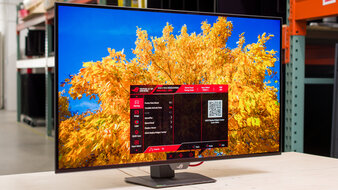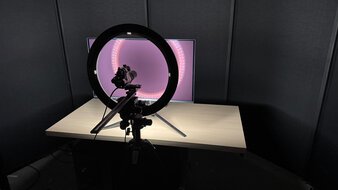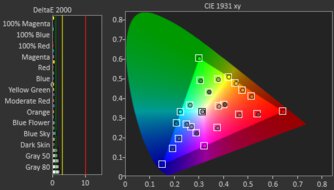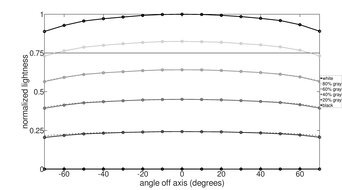One of the latest advancements in monitor technology is OLED panels. They're different from LCD panel types because instead of having a backlight, they have individual pixels that can turn on and off. This helps them display perfect blacks in dark rooms without any haloing around bright objects. Besides their superior picture quality versus LCD displays, most OLEDs are beneficial for gaming as they have a near-instantaneous response time for sharp motion.
There are many different OLED models out there, including both WOLED and QD-OLED, with various sizes, resolutions, and refresh rates. Since many models use the same panel as their competitors, choosing one over another can come down to features, price, and availability, which we consider for this recommendation. There are various things you should consider for gaming, like the input lag and refresh rate.
However, there are downsides to using an OLED, as they're prone to burn-in when exposed to the same static elements over time, like if you only use it for work all day, every day. That said, there's less of a risk of burn-in if you use the monitor for varied usage. They also don't get as bright as many LED-backlit LCD monitors, so they're best used in a dark environment, and OLEDs have VRR flicker with changing frame rates. Plus, the black levels rise, and dark colors desaturate in bright rooms on QD-OLEDs. That said, QD-OLEDs generally offer the best picture quality with more vivid colors than WOLEDs. A downside of WOLEDs is that they tend to have a gamma shift at low refresh rates, causing a loss of details in dark scenes.
We've bought and tested more than 375 monitors, and below are our picks for the best OLED monitors available. See our recommendations for the best HDR gaming monitors, the best HDR monitors, and, if you're concerned about the risk of burn-in, the best Mini LED monitors. Check out the best OLED TVs, too, and learn about the best monitor brands.
Quick Look






We buy and test more than 30 monitors each year, with units that we buy completely on our own, without any cherry-picked units or samples. We put a lot into each unbiased, straight-to-the-point review, and there's a whole process from purchasing to publishing, involving multiple teams and people. We do more than just use the monitor for a week; we use specialized and custom tools to measure various aspects with objective data-based results. We also consider multiple factors before making any recommendations, including the monitor's cost, its performance against the competition, and whether or not it's easy to find.
-
Best OLED Monitor
 PC Gaming9.1Console Gaming9.4HDR Picture9.4SDR Picture10Brightness7.2Response Time9.9Color Accuracy9.2Size27"Max Refresh Rate240 HzPixel TypeQD-OLEDScreen FinishGlossySee all our test resultsNative Resolution3840 x 2160
PC Gaming9.1Console Gaming9.4HDR Picture9.4SDR Picture10Brightness7.2Response Time9.9Color Accuracy9.2Size27"Max Refresh Rate240 HzPixel TypeQD-OLEDScreen FinishGlossySee all our test resultsNative Resolution3840 x 2160The best OLED gaming monitor we've tested is the ASUS ROG Swift OLED PG27UCDM. It's a QD-OLED that combines a 4k resolution with a 240Hz refresh rate, making it ideal for gamers who want a responsive feel and a detailed image. It has everything you'd expect from a premium OLED gaming monitor, like a near-instantaneous response time for sharp motion. It also takes full advantage of gaming consoles and modern graphics cards because it supports both HDMI and DisplayPort 2.1 bandwidth. It even has remarkable HDR picture quality with vivid colors and bright highlights, which is what you should expect with a QD-OLED. One of its advantages is that it has high pixel density, and it doesn't have fringing around text like on larger QD-OLEDs.
This monitor is part of a group of 27-inch, 4k QD-OLEDs that all perform similarly. This particular model is worth getting over other options because it has some extra features, like a USB hub and KVM switch, and it also supports Dolby Vision, which is a nice touch for a gaming monitor. However, you can also check out the Dell Alienware AW2725Q if you want something cheaper, but it doesn't get as bright as the ASUS and lacks DisplayPort 2.1 bandwidth.
-
Best 32-Inch OLED Monitor
 PC Gaming9.2Console Gaming9.2HDR Picture8.9SDR Picture9.9Brightness7.2Response Time9.8Color Accuracy8.5Size32"Max Refresh Rate480 HzPixel TypeOLEDScreen FinishGlossySee all our test resultsNative Resolution3840 x 2160
PC Gaming9.2Console Gaming9.2HDR Picture8.9SDR Picture9.9Brightness7.2Response Time9.8Color Accuracy8.5Size32"Max Refresh Rate480 HzPixel TypeOLEDScreen FinishGlossySee all our test resultsNative Resolution3840 x 2160If you find that the 27-inch screen of the ASUS ROG Swift OLED PG27UCDM is too small for your needs, there are plenty of 32-inch OLEDs you can check out. If that's what you're interested in, look into the ASUS ROG Strix OLED XG32UCWMG. It has a native 4k resolution and a 240Hz refresh rate like the PG27UCDM. However, an advantage of getting this is that it has a dual-mode feature to boost the refresh rate to 480Hz with a lower 1080p resolution. This gives it versatility for playing different types of games. That said, there are some drawbacks in terms of features compared to the PG27UCDM because it doesn't support Dolby Vision or DisplayPort 2.1 bandwidth.
Although its WOLED panel doesn't have the same vivid colors as the PG27UCDM, it's actually a better choice to use in bright rooms. It uses a TrueBlack glossy coating that maintains very low black levels in a bright room, so blacks don't look purple like on a QD-OLED. Plus, the coating makes images look clear, but the downside is that it has mirror-like reflections. If that bothers you, the LG 32GS95UE-B is a similar option with the same screen specs, but it has a matte coating that's better at absorbing light. However, images aren't as clear with this coating.
-
Best 1440p OLED Monitor
 PC Gaming9.2Console Gaming9.1HDR Picture9.5SDR Picture10Brightness7.2Response Time9.8Color Accuracy8.9Size27"Max Refresh Rate360 HzPixel TypeQD-OLEDScreen FinishGlossySee all our test resultsNative Resolution2560 x 1440
PC Gaming9.2Console Gaming9.1HDR Picture9.5SDR Picture10Brightness7.2Response Time9.8Color Accuracy8.9Size27"Max Refresh Rate360 HzPixel TypeQD-OLEDScreen FinishGlossySee all our test resultsNative Resolution2560 x 1440If you don't need a 32-inch, 4k monitor like the ASUS ROG Strix OLED XG32UCWMG, there are plenty of 1440p OLEDs you can get for cheaper, like the ASUS ROG Strix OLED XG27ACDNG. The lower resolution results in less sharp and detailed images than on the 4k ASUS monitors recommended above. This means it requires less bandwidth from your graphics card to reach high frame rates, as the XG27ACDNG has a higher 360Hz refresh rate than the 4k ASUS monitors for a smoother feel.
Besides the lower resolution, it has picture quality similar to that of the ASUS ROG Swift OLED PG27UCDM because it's another QD-OLED. It comes with all its benefits, including a wide color gamut with vivid colors. However, it doesn't perform well in bright rooms because blacks look purple. If you want a 1440p OLED that's better to use in a well-lit space, check out the LG 27GX700A-B. It uses the new RGB Tandem OLED panel that gets brighter, but it achieves this by overbrightening the image, so it's not accurate. It also has a lower refresh rate than the XG27ACDNG, but it's still worth getting if you want a bright OLED.
-
Best High Refresh Rate OLED Monitor
 PC Gaming9.2Console Gaming9.0HDR Picture8.9SDR Picture9.9Brightness6.7Response Time9.9Color Accuracy8.4Size27"Max Refresh Rate480 HzPixel TypeOLEDScreen FinishMatteSee all our test resultsNative Resolution2560 x 1440
PC Gaming9.2Console Gaming9.0HDR Picture8.9SDR Picture9.9Brightness6.7Response Time9.9Color Accuracy8.4Size27"Max Refresh Rate480 HzPixel TypeOLEDScreen FinishMatteSee all our test resultsNative Resolution2560 x 1440If you're looking for the best OLED gaming monitor and need a high refresh rate, like for competitive esports gaming, there are some 480Hz OLEDs, like the LG 27GX790A-B. Although an option like the ASUS ROG Strix OLED XG32UCWMG has a 480Hz dual mode, this is with a 1080p resolution, whereas the LG has a higher 1440p resolution. This means it combines a smooth and responsive feel with a detailed image.
One difference with the ASUS ROG Strix OLED XG27ACDNG is that this LG isn't a QD-OLED, so colors are less vivid; instead, it has a WOLED panel. That means you still get all the benefits of an OLED with perfect blacks against bright highlights and incredibly sharp motion. The black levels don't rise as much in a bright room either, so it's fine to use with some lights around, but it doesn't get bright enough to fight intense glare. It supports HDMI and DisplayPort 2.1 bandwidth, which is great if you have a high-end graphics card that can take advantage of those ports. If you don't need the DisplayPort 2.1 bandwidth, the ASUS ROG Swift OLED PG27AQDP is a good alternative that you can find for less, but it has a few bugs.
-
Best Ultrawide OLED Monitor
 PC Gaming9.1Console Gaming9.1HDR Picture9.4SDR Picture10Brightness6.8Response Time9.8Color Accuracy9.4Size34"Max Refresh Rate240 HzPixel TypeQD-OLEDScreen FinishGlossySee all our test resultsNative Resolution3440 x 1440
PC Gaming9.1Console Gaming9.1HDR Picture9.4SDR Picture10Brightness6.8Response Time9.8Color Accuracy9.4Size34"Max Refresh Rate240 HzPixel TypeQD-OLEDScreen FinishGlossySee all our test resultsNative Resolution3440 x 1440While 27-inch and 32-inch OLEDs offer plenty of screen space for most gamers, there are certain types of games that benefit from extra screen space on the sides. If you play atmospheric or racing games, you should consider an ultrawide OLED, like the Dell Alienware AW3425DW, which is wider than all the monitors recommended above for a more immersive feel. It's another 240Hz QD-OLED, like the ASUS ROG Swift OLED PG27UCDM, so it offers similar gaming performance with the same sharp motion, fluid feel, and incredible picture quality.
However, there are some downsides to getting it. It has a lower 3440x1440 resolution than the PG27CUDM, so images aren't as detailed and sharp, and it has more fringing around letters. Its curved screen and glossy coating also contribute to reflections looking more warped than on a matte monitor, like the LG 27GX790A-B. If that would bother you, or you need to use the monitor in a bright room and you don't want the purple tint that QD-OLEDs have, check out the LG 34GS95QE-B. It's a matte WOLED that maintains low black levels in bright rooms, and it also has a 240Hz refresh rate. However, its colors aren't as vivid as on the Dell.
Notable Mentions
-
MSI MPG 272URX QD-OLED:
The MSI MPG 272URX QD-OLED is a 27-inch, 4k QD-OLED that competes with the ASUS ROG Swift OLED PG27UCDM. It has many of the same features and performance as the ASUS, and usually costs less, but it doesn't support Dolby Vision.
See our review -
ASUS ROG Swift OLED PG32UCDM:
The ASUS ROG Swift OLED PG32UCDM is a 32-inch QD-OLED with a native 4k resolution and 240Hz refresh rate. It's an alternative to the ASUS ROG Strix OLED XG32UCWMG if you want a QD-OLED with more vivid colors. However, the PG32UCDM doesn't have a dual-mode feature to boost the refresh rate like on the XG32UCWMG.
See our review -
Gigabyte AORUS FO27Q3:
The Gigabyte AORUS FO27Q3 is a 1440p, 360Hz QD-OLED that competes with the ASUS ROG Strix OLED XG27ACDNG. Because they perform so similarly, you can't go wrong with either, and you should get whichever you can get for cheaper, but the Gigabyte can be harder to find at times.
See our review -
Sony INZONE M10S:
The Sony INZONE M10S is a 1440p, 480Hz monitor that competes with the LG 27GX790A-B. Both perform so similarly, and you can't go wrong with either, but the LG is usually cheaper.
See our review -
LG 45GX950A-B:
The LG 45GX950A-B is a 45-inch ultrawide with a 5k2k resolution. It's something to consider over the Dell Alienware AW3425DW if you want the bigger screen size, but it also comes with a big price increase.
See our review
Recent Updates
Nov 26, 2025:
We replaced the ASUS ROG Swift OLED PG32UCDM with the ASUS ROG Strix OLED XG32UCWMG, which has a dual-mode feature that boosts its refresh rate. We also reordered the categories for a better flow. In the Notable Mentions, we replaced the Dell Alienware AW3225QF and the Samsung Odyssey OLED G9/G95SC S49CG95 with the PG32UCDM and the LG 45GX950A-B.
Sep 12, 2025:
We replaced the Gigabyte AORUS FO32U2P with the ASUS ROG Swift OLED PG32UCDM, which is easier to find. We also replaced the LG 34GS95QE-B with the Dell Alienware AW3425DW because it has better picture quality, and renamed the category to the 'Best 34-Inch OLED Monitor.' We renamed the LG 27GX790A-B to the 'Best High Refresh Rate OLED Monitor.' In the Notable Mentions, we replaced the PG32UCDM with the MSI MPG 272URX QD-OLED.
Jul 10, 2025:
We made several changes according to price and availability, and for consistency with other recommendations. We replaced the MSI MPG 321URX QD-OLED with the Gigabyte AORUS FO32U2P and renamed it to the 'Best 32-Inch Monitor.' We also renamed the ASUS ROG Swift OLED PG27UCDM to the 'Best Monitor.' We replaced the MSI MPG 271QRX QD-OLED, Sony INZONE M10S, and the MSI MPG 341CQPX QD-OLED with the ASUS ROG Strix OLED XG27ACDNG, LG 27GX790A-B, and the LG 34GS95QE-B, respectively. In the Notable Mentions, we replaced the 27GX790A-B, MSI MPG 322URX QD-OLED, and the ASUS ROG Strix OLED XG27AQDMG with the M10S, ASUS ROG Swift OLED PG32UCDM, and the Samsung Odyssey OLED G9/G95SC S49CG95.
Apr 18, 2025:
We added the ASUS ROG Swift OLED PG27UCDM as the 'Best 27-Inch Monitor' to give another option and renamed the MSI MPG 271QRX QD-OLED to the 'Best 1440p Monitor.' In the Notable Mentions, we replaced the ASUS ROG Strix OLED XG27ACDNG and the ASUS ROG Swift OLED PG32UCDM with the LG 27GX790A-B, the MSI MPG 322URX QD-OLED, and the ASUS ROG Strix OLED XG27AQDMG to reflect changes in the recommendation and the current monitor market.
Feb 19, 2025:
We replaced the Samsung Odyssey OLED G8/G80SD S32DG80 with the MSI MPG 321URX QD-OLED for consistency with other recommendations, as the MSI is cheaper. We also replaced the LG 32GS95UE-B with the Sony INZONE M10S and renamed it the 'Best 480Hz Monitor' to represent the current market better. In the Notable Mentions, we replaced the Dell Alienware AW2725DF and the ASUS ROG Swift OLED PG32UCDP with the ASUS ROG Strix OLED XG27ACDNG and the Gigabyte AORUS FO27Q3. We introduced a new format to the recommendation and updated the text to reflect these changes.
All Reviews
Our recommendations are based on what we think are the best OLED monitors currently available, including the best OLED gaming monitor. They're adapted to be valid for most people in each price range. The rating is based on our review, factoring in price and feedback from our visitors.
If you'd prefer to make your own decision, here's the list of all of our OLED monitor reviews. Be careful not to get too caught up in the details. Most monitors are good enough to please most people, and the things we fault monitors on are often not noticeable unless you really look for them.















